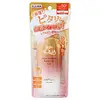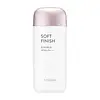What's inside
What's inside
 Key Ingredients
Key Ingredients

 Benefits
Benefits

 Concerns
Concerns

 Ingredients Side-by-side
Ingredients Side-by-side

Water
Skin ConditioningAlcohol Denat.
AntimicrobialEthylhexyl Methoxycinnamate
UV AbsorberButylene Glycol
HumectantIsononyl Isononanoate
EmollientGlycerin
HumectantDiethylamino Hydroxybenzoyl Hexyl Benzoate
UV FilterDiethylhexyl Succinate
EmollientBis-Ethylhexyloxyphenol Methoxyphenyl Triazine
Skin ConditioningLoess Extract
Skin ConditioningSodium Hyaluronate
HumectantSilica
AbrasiveEthylhexyl Triazone
UV AbsorberPolyglyceryl-10 Pentaisostearate
EmollientHydrogenated Polyisobutene
EmollientAcrylates/C10-30 Alkyl Acrylate Crosspolymer
Emulsion StabilisingMyristyl Myristate
EmollientMelaleuca Alternifolia Leaf Oil
AntioxidantFructose
HumectantDiethoxyethyl Succinate
SolventDisodium EDTA
Xanthan Gum
EmulsifyingPhenoxyethanol
PreservativeBiosaccharide Gum-4
Skin ConditioningWater, Alcohol Denat., Ethylhexyl Methoxycinnamate, Butylene Glycol, Isononyl Isononanoate, Glycerin, Diethylamino Hydroxybenzoyl Hexyl Benzoate, Diethylhexyl Succinate, Bis-Ethylhexyloxyphenol Methoxyphenyl Triazine, Loess Extract, Sodium Hyaluronate, Silica, Ethylhexyl Triazone, Polyglyceryl-10 Pentaisostearate, Hydrogenated Polyisobutene, Acrylates/C10-30 Alkyl Acrylate Crosspolymer, Myristyl Myristate, Melaleuca Alternifolia Leaf Oil, Fructose, Diethoxyethyl Succinate, Disodium EDTA, Xanthan Gum, Phenoxyethanol, Biosaccharide Gum-4
Hydrolyzed Chestnut Extract
Skin ProtectingCyclopentasiloxane
EmollientSilica
AbrasiveZinc Oxide
Cosmetic ColorantDipropylene Glycol
HumectantLauryl PEG-10 Tris(Trimethylsiloxy)Silylethyl Dimethicone
EmulsifyingIsopropyl Palmitate
EmollientEthylhexyl Salicylate
UV AbsorberEthylhexyl Methoxycinnamate
UV AbsorberCaprylyl Methicone
Skin ConditioningTitanium Dioxide
Cosmetic ColorantAlcohol Denat.
AntimicrobialC12-15 Alkyl Benzoate
AntimicrobialAcrylates/Dimethicone Copolymer
Skin ConditioningVp/Hexadecene Copolymer
Limonia Acidissima Extract
Skin ConditioningOpuntia Ficus-Indica Extract
Skin ConditioningVerbena Officinalis Leaf Extract
MaskingAloe Barbadensis Leaf Extract
EmollientCinnamomum Cassia Bark Extract
MaskingPsidium Guajava Leaf Extract
AstringentRosa Rugosa Flower Extract
Skin ConditioningBiosaccharide Gum-4
Skin ConditioningBis-Ethylhexyloxyphenol Methoxyphenyl Triazine
Skin ConditioningMagnesium Sulfate
Dimethicone/Vinyl Dimethicone Crosspolymer
Skin ConditioningDimethicone
EmollientDiethylamino Hydroxybenzoyl Hexyl Benzoate
UV FilterQuaternium-18 Bentonite
Aluminum Hydroxide
EmollientStearic Acid
CleansingHydrogen Dimethicone
Water
Skin ConditioningSilica Dimethyl Silylate
EmollientSodium Benzoate
MaskingTocopheryl Acetate
AntioxidantPotassium Sorbate
PreservativePolyhydroxystearic Acid
EmulsifyingIsopropyl Myristate
EmollientIsostearic Acid
CleansingLecithin
EmollientEthylhexyl Palmitate
EmollientPolyglyceryl-3 Polyricinoleate
EmulsifyingDisodium EDTA
Phenoxyethanol
PreservativeCI 77491
Cosmetic ColorantCI 77492
Cosmetic ColorantHexyl Cinnamal
PerfumingBenzyl Salicylate
PerfumingHydrolyzed Chestnut Extract, Cyclopentasiloxane, Silica, Zinc Oxide, Dipropylene Glycol, Lauryl PEG-10 Tris(Trimethylsiloxy)Silylethyl Dimethicone, Isopropyl Palmitate, Ethylhexyl Salicylate, Ethylhexyl Methoxycinnamate, Caprylyl Methicone, Titanium Dioxide, Alcohol Denat., C12-15 Alkyl Benzoate, Acrylates/Dimethicone Copolymer, Vp/Hexadecene Copolymer, Limonia Acidissima Extract, Opuntia Ficus-Indica Extract, Verbena Officinalis Leaf Extract, Aloe Barbadensis Leaf Extract, Cinnamomum Cassia Bark Extract, Psidium Guajava Leaf Extract, Rosa Rugosa Flower Extract, Biosaccharide Gum-4, Bis-Ethylhexyloxyphenol Methoxyphenyl Triazine, Magnesium Sulfate, Dimethicone/Vinyl Dimethicone Crosspolymer, Dimethicone, Diethylamino Hydroxybenzoyl Hexyl Benzoate, Quaternium-18 Bentonite, Aluminum Hydroxide, Stearic Acid, Hydrogen Dimethicone, Water, Silica Dimethyl Silylate, Sodium Benzoate, Tocopheryl Acetate, Potassium Sorbate, Polyhydroxystearic Acid, Isopropyl Myristate, Isostearic Acid, Lecithin, Ethylhexyl Palmitate, Polyglyceryl-3 Polyricinoleate, Disodium EDTA, Phenoxyethanol, CI 77491, CI 77492, Hexyl Cinnamal, Benzyl Salicylate
 Reviews
Reviews

Ingredients Explained
These ingredients are found in both products.
Ingredients higher up in an ingredient list are typically present in a larger amount.
Alcohol Denat. is an alcohol with a denaturant property. It is created by mixing ethanol with other additives.
This ingredient gets a bad rep because it is irritating and drying - mostly due to its astringent property. Astringents draw out natural oils in tissue, constricting pores and leaving your skin dried out.
However, alcohol denat. is not all that bad.
Due to its low molecular weight, alcohol denat. tends to evaporate quickly. One study on pig skin found half of applied alcohol evaporated in 10 seconds and less than 3% stayed on skin.
This also helps other ingredients become better absorbed upon application.
Studies are conflicted about whether this ingredient causes skin dehydration. One study from 2005 found adding emollients to propanol-based sanitizer decreased skin dryness and irritation. Another study found irritation only occurs if your skin is already damaged.
Small amounts of alcohol are generally tolerated by oily skin or people who live in humid environments.
The rule of thumb is if this alcohol is near the end of an ingredients list, it will probably not affect your skin much.
Also...
This ingredient has antimicrobial and solvent properties.
The antimicrobial property helps preserve products and increase their shelf life. As a solvent, it helps dissolve other ingredients.
Other types of astringent alcohols include:
Learn more about Alcohol Denat.This is a fermented gum derived from sorbitol, a sugar alcohol.
According to a manufacturer, this ingredient's high molecular weight makes it an effective emollient.
Emollients help keep the skin hydrated by preventing water from evaporating.
Learn more about Biosaccharide Gum-4You might know this ingredient as Tinosorb S or Bemotrizinol. It is a UV filter that covers both UVA and UVB rays.
This ingredient has two peak UV absorption peaks ( 310 and 340 nm) and is able to absorb both UV-A and UV-B rays. This ingredient works by preventing UV rays from reaching and damaging your skin.
On top of that - it is highly photostable and helps prevent the photodegration of other sunscreen ingredients such as avobenzone.
Tinosorb S is allowed in the EU, Australia, and Asia. It is close to being approved by the FDA and we'll hopefully get this ingredient in the U.S. by late 2025.
Fun fact: Tinosorb S is the most effective UV absorber at maximum concentration (measured by SPF) permitted in the EU.
This ingredient is oil-soluble, so your oil-cleansers will take this right off at night.
Learn more about Bis-Ethylhexyloxyphenol Methoxyphenyl TriazineDiethylamino Hydroxybenzoyl Hexyl Benzoate (DHHB) is a chemical UV-A absorber. It is formulated for high UVA protection (320-400 nm).
DHHB is well-liked for:
DHHB has been approved by the EU, Japan, Taiwan, and South America for use up to 10%. Unfortunately, it has not been approved for use in the US or Canada due to slow regulatory processes.
This ingredient is soluble in oils, fats, and lipids.
Learn more about Diethylamino Hydroxybenzoyl Hexyl BenzoateDisodium EDTA plays a role in making products more stable by aiding other preservatives.
It is a chelating agent, meaning it neutralizes metal ions that may be found in a product.
Disodium EDTA is a salt of edetic acid and is found to be safe in cosmetic ingredients.
Learn more about Disodium EDTAEthylhexyl Methoxycinnamate is an organic compound that provides UVB protection. It often goes by the more common name of octinoxate. It is created from methoxycinnamic acid and 2-ethylhexanol.
Ethylhexyl Methoxycinnamate absorbs UVB rays with wavelengths between 280-320 nm. UV absorbers protect your skin by using chemical reactions to convert UV rays into heat and energy.
UVB (290-320 nm) rays emit more energy than UVA rays. They are capable of damaging DNA, causing sunburns and are thought to be linked to skin cancer.
The state of Hawaii has banned sunscreens containing octinoxate due to its potential impact on coral reefs. More research is needed to bridge gaps in this research. The European Union allows higher levels of octinoxate in sunscreens than the US and Australia.
Ethylhexyl Methoxycinnamate is oil soluble. It is not stable and may lose efficacy when exposed to sunlight.
Learn more about Ethylhexyl MethoxycinnamatePhenoxyethanol is a preservative that has germicide, antimicrobial, and aromatic properties. Studies show that phenoxyethanol can prevent microbial growth. By itself, it has a scent that is similar to that of a rose.
It's often used in formulations along with Caprylyl Glycol to preserve the shelf life of products.
Silica, also known as silicon dioxide, is a naturally occurring mineral. It is used as a fine, spherical, and porous powder in cosmetics.
Though it has exfoliant properties, the function of silica varies depending on the product.
The unique structure of silica enhances the spreadability and adds smoothness, making it a great texture enhancer.
It is also used as an active carrier, emulsifier, and mattifier due to its ability to absorb excess oil.
In some products, tiny microneedles called spicules are made from silica or hydrolyzed sponge. When you rub them in, they lightly polish away dead skin layers and enhance the penetration of active ingredients.
Learn more about SilicaWater. It's the most common cosmetic ingredient of all. You'll usually see it at the top of ingredient lists, meaning that it makes up the largest part of the product.
So why is it so popular? Water most often acts as a solvent - this means that it helps dissolve other ingredients into the formulation.
You'll also recognize water as that liquid we all need to stay alive. If you see this, drink a glass of water. Stay hydrated!
Learn more about Water